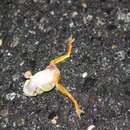en
names in breadcrumbs


They are known as pine barrens tree frogs because they are found only in the Pine Barrens forests of the eastern United States from New Jersey to South Carolina. (Conant, 1975)
Hyla andersonii are considered an endangered species. Recently, many pools which provided a habitat for Hyla andersonii have been destroyed for the sake of development. The pools have been drained or dried up and they no longer have a place to live. The only way to preserve this species is to protect the area of the Pine Barrens on the eastern coast of the U.S. Another endangerment is DDT. There now remains only three main concentrations of the Pine Barrens Tree Frog, the largest of which is in New Jersey. (Beebee, T.J.C.)
US Federal List: endangered
IUCN Red List of Threatened Species: near threatened
Development - Life Cycle: metamorphosis
Adult pine barrens tree frogs are predatory. In the larval stage tree frogs eat vegetation or algae in the water. Adults catch flies, small slugs, snails, beetles, butterflies or moths. They catch these organisms with their tongue. While the tadpole has reduced teeth, the teeth grow slightly when an adult. (Beebee, 1985)
Hyla andersonii range from southern New Jersey to South Carolina. On a few occaisions, however, they have been seen as far south as the Florida panhandle and as far west as Alabama.
(Conant, 1975)
Biogeographic Regions: nearctic (Native )
Hyla andersonii reside in pools during part of the year, but when those dry up during the warmer summer months, they live on the damp soil in dark shaded areas of raspberry bushes and other brush. Whereas tadpoles swim in pools or ponds, adults are terrestrial, but live near water. Research suggests that that low pH in natural ponds limits Hyla andersonii to acidic ponds. (Grzmek, 1970; Pehek, 1995; Underhill, 1951; Wright & Allen, 1961)
Terrestrial Biomes: forest
Hyla andersonii vary in size. Adult females are between 30-41 mm in length and adult males are between 38-47mm in length. Hyla andersoni are bright green with plum or lavender stripes bordered by white running along their sides. On the inner femur and on the groin there are patches of orange, which are concealed when they are in resting/sitting position. The ventral surface is white and the dorsal surface entirely green. This coloration acts to comouflage them in vegetation. On females there are also white bordered patches of darker green on either side of the throat and the mouth is edged in white. Their feet have sticky pads on each finger in order to grip tree bark or leaves. (Conant, 1975)
Other Physical Features: ectothermic ; bilateral symmetry
Hyla andersonii reproduce sexually. Matin occurs during the spring, usually from May 1-July 20, the latter half of the season occurring mostly in the southern areas of North and South Carolina. Age at sexual maturity is 2 to 3 years old. Ovulation is induced by males while mounting the female from the back. Males release sperm directly onto the eggs as they are released by females. (Conant, 1975; Beebee 1985)
Key Reproductive Features: gonochoric/gonochoristic/dioecious (sexes separate)